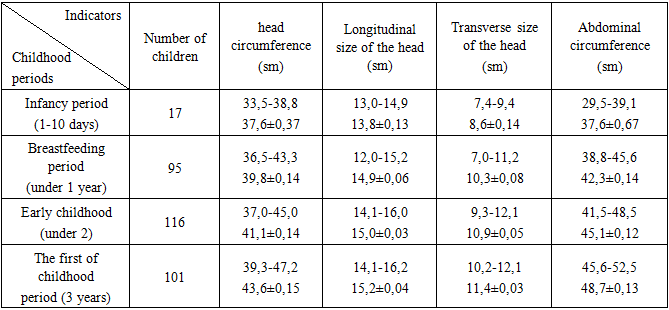-
Paper Information
- Next Paper
- Previous Paper
- Paper Submission
-
Journal Information
- About This Journal
- Editorial Board
- Current Issue
- Archive
- Author Guidelines
- Contact Us
American Journal of Medicine and Medical Sciences
p-ISSN: 2165-901X e-ISSN: 2165-9036
2024; 4(2): 297-299
doi:10.5923/j.ajmms.20241402.28
Received: Jan. 11, 2024; Accepted: Feb. 3, 2024; Published: Feb. 8, 2024

Indicators of Physical Development of Healthy Boys from Birth to 3 Years
Saidova S. Y., Khasanova D. A.
Department of Anatomy, Clinical Anatomy (OSTA), Bukhara State Medical Institute named after Abu Ali Ibn Sino, Uzbekistan
Copyright © 2024 The Author(s). Published by Scientific & Academic Publishing.
This work is licensed under the Creative Commons Attribution International License (CC BY).
http://creativecommons.org/licenses/by/4.0/

Physical development is one of the main criteria of health. Physical development is a dynamic process of a child's growth and development at different ages of childhood, and it is considered one of the main indicators of health status. This article presents indicators of physical development of healthy boys.
Keywords: Body, Measure, Anthropometric study
Cite this paper: Saidova S. Y., Khasanova D. A., Indicators of Physical Development of Healthy Boys from Birth to 3 Years, American Journal of Medicine and Medical Sciences, Vol. 4 No. 2, 2024, pp. 297-299. doi: 10.5923/j.ajmms.20241402.28.
Article Outline
1. Introduction
- Children's health is the greatest wealth of any country. Physical development is the most important health indicator. It is the development during childhood that determines the main characteristics of the health of this generation [2,8].Children's health is the greatest asset of any country. Physical development is the most important health indicator. It is the development during childhood that determines the main characteristics of the health of this generation [4,8].Physical indicators are important indicators of personality development and body composition. These parameters depend on the lifestyle, age, gender, diet and ethnic group of the population [1,3].Physical development is a directly related process between morbidity and mortality [6,9].The term anthropometry is derived from the Greek words "anthropo" meaning "man" and "metria" meaning "measurement". Anthropometry is an important standardized and non-invasive method of studying human biological differences. Anthropometric indicators and body composition are the main indicators of personal growth [7,5].
2. Research Materials and Methods
- This work presents an anthropometric analysis of healthy children born in Bukhara region.
3. Research Result
- Children's height, body weight, chest circumference are the main criteria for assessing physical development. This article presents a comparative analysis of the morphometric parameters of these criteria, which determine the physical development of children, measurements of head and abdominal circumference.Studies have shown that the height of newborn healthy boys is from 48.5 to 58.0 sm, the average is 52.2 ± 0.66 sm, body mass is 2, From 6 to 4.3 kg, the average was 3.6 ± 0.11 kg. We know that newborns usually lose physiological weight in 2-5 days, that is, children lose weight from 200 to 500 grams. This is considered a normal state, and after 9-11 days, the child's body mass at birth is restored. The circumference of the chest in baby boys is from 38.0 to 44.8 sm when taking a deep breath, on average - 40.6 ± 0.47 sm, and when exhaling, the chest size is from 32.5 It was 39.4 sm, the average was 37.6 ± 0.48 sm.The growth rate of one-year-old boys ranges from 60.5 to 68.3 sm, the average is 64.6 ± 0.16 sm. At this age, the body weight is from 4.8 to 7.8 kg, on average - 6.4 ± 0.06 kg. The circumference of the chest is 48.6 to 54.1 sm when taking a deep breath on average - 50.2 ± 0.11 sm, and when fully exhaling, the size of the chest changes from 42.0 to 48.9 sm, on average - 46.1 ± 0.14 sm organized.As a result of our research, the height of two-year-old boys ranges from 67.6 to 76.5 sm, the average is 71.8 ± 0.16 cm. At this age, it was found that the body mass is from 6.6 to 9.5 kg, on average - 8.1 ± 0.16 kg. The circumference of the chest during deep breathing is 47.8 to 54.6 sm, on average - 50.7 ± 0.12 sm, and when fully exhaling, the circumference of the chest is 43.7 to 49.6 sm. It changed to 46.7 ± 0.10 sm on average.From the indicators of physical development of healthy three-year-old boys, the height growth indicator is from 82.1 to 91.1 sm, the average is 86.8 ± 0.18 sm, body weight is from 8.3 to 11.2 kg, the average is 9.6 ± 0.05 kg. The circumference of the chest during deep breathing is 51.3 to 56.8 sm, on average - 52.8 ± 0.11 sm, and when fully exhaling, the size of the chest is 44.8 to 51.6 sm. changed up to, the average was 47.1 ± 0.13 sm.
|
|
4. The Results of the Study
- In healthy boys from birth to 3 years of age, it was found that physical development increases rapidly at 3 years of age.
 Abstract
Abstract Reference
Reference Full-Text PDF
Full-Text PDF Full-text HTML
Full-text HTML
